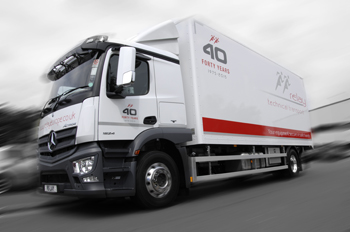In our 40th Anniversary Year in 2015, Relay has been looking back on how our customers and the types of assignment they entrust to us have transformed radically. Originally, we began our business in 1975 by transporting drilling equipment to service the North Sea oil boom, centred on Aberdeen. So moving from heavy duty bulk haulage to specialising in deliveries of high value electronic business equipment and scientific and medical apparatus could not have been a more dramatic change.
The decision was the right one for us to take, because there was and is a major requirement for specialised transport and logistics in these high technology sectors. Services demand the highest levels of quality, the utmost care and professionalism, together with optimum security and exceptional channels of communication. We always bear in mind that the equipment we collect and deliver is distinct from that handled by most haulage companies and freight services providers. Dealing with critically important devices from sophisticated office automation to ultra-low temperature freezers for blood plasma is by no means run of the mill!
Back in 2002, we reported in “the baton,” our regular customer e-newsletter, on our ability to transport these very items, enabled by the expertise of our people and our flexible fleet of over 50 vehicles, ranging from 3.5 tonne vans up to 32 tonne tractor and trailer units. The same issue recorded that we had 60,000 square feet of specialised warehousing to offer over our three depots, including a recently opened ultra-modern 20,000 square foot secure storage area at Warrington. The new transport logistics resource, we explained, was “operated by an experienced and committed workforce, heated, fully racked and ideal for accommodating high tech electronic equipment and scientific instrumentation that require an exceptional degree of care and attention.”
Technical support and challenging installations
 Taking a look at past issues of the Relay newsletter is more than just a trip down memory lane. It reveals how continual developments in supply chain solutions needed to be implemented to meet changes in the technology of equipment being handled and operational priorities of security, cost efficiency and environmental responsibility.
Taking a look at past issues of the Relay newsletter is more than just a trip down memory lane. It reveals how continual developments in supply chain solutions needed to be implemented to meet changes in the technology of equipment being handled and operational priorities of security, cost efficiency and environmental responsibility.
Fast forward two years, and we were focusing on our recently installed a state-of-the-art track & trace system involving hand-held PDA systems throughout our 50-vehicle fleet. We have always been at the forefront of transport companies in our ready adoption and investment in the latest IT and the progress of goods in transit could now be checked at any time, problems redressed and delivery status/POD instantly confirmed. The high degree of automation involved in the information flow made for savings on administrative
time and costs for both us and our customers.
Five years later, in April 2009, “the baton” reported that the days of the weighty “brick” type PDAs had thankfully come to an end and that every vehicle in the Relay fleet was now equipped with the latest slimmed-down, easy-to-handle PDA devices designed to enhance every aspect of logistics transport and goods tracking.
There were also some very exciting transportation specialist assignments that we informed our customers about that year through a series of newsletters. These included the delivery of two bulky but fragile laboratory autoclaves up to the 6th floor of the School of Pharmacy in London’s Brunswick Square, which was a terrific logistical challenge for Relay. Taking place early on a Saturday morning to disrupt traffic to a minimum, the 330 kilo autoclaves were skilfully lifted by crane and installed in only 1½ hours!
The need for providing freight transport for heavy but delicate and sophisticated equipment brought new units to our fleet, which now numbered 55 vehicles. It prompted our acquisition of a superb new Mercedes-Benz Actros articulated truck with 3-tonne bar tail lift. This was the ideal response to a range of requirements from transporting valuable MFP (multi-functional product) photocopiers to server relocation.
Over recent years, the challenges of complexity and demands for transparency have been important features of the transport and logistics sector. It is no longer a question of simply shifting goods from A to B, however good haulage companies may be at doing it.
Accurately planned and rigorously implemented supply chain solutions are increasingly required, with seamless service quality applied both nationally and globally. Fortunately, Relay has been able to supply consistent high standards both in the UK and throughout our European transport and overseas freight forwarding operations via our international business partnership networks.
Key aspects of effective supply chain solutions are communication and visibility, and this was well illustrated in the Relay newsletter case study on the Mandata system Relay installed at the Basildon offices of our customers Konica Minolta, which provides the very latest in enhanced route mapping technology.
Two very large LCD widescreens display a real-time overview of our fleet activities, identifying the trucks shipping Konica Minolta (KM) multi-functional photocopying equipment and defining the status of each delivery to all KM logistics personnel continually throughout the day.
The story described how our trucks are colour coded for identification – grey if not on a KM job, red if it’s a KM delivery in transit and green when the KM shipment has arrived at its destination. Each shipment is also coded by a transport reference number. Additionally, sensitive jobs such as those on a time-critical schedule are electronically flagged for easy recognition by the transportation specialist team back at base.
The huge benefit of the mapping system is the level of detail it provides for planning a transport logistics operation of Konica Minolta’s complexity. For instance, a series of colour coded pushpins will show where a truck is due to stop on a route with multiple deliveries, both KM and non-KM jobs. Therefore, in the middle of the day, the transport team will know which deliveries have taken place successfully, where delivery has been aborted and where destinations have not yet been reached.
Relay’s IT transport and logistics systems are being continually updated and upgraded. Naturally, our customer newsletter has not reported on every new development, because that would be information overload. But the following initiatives we adopted over the past five years have been important landmarks:
- Geofencing: a positioning tool to pinpoint the exact status of a delivery or collection. Geofencing creates a virtual area on a map surrounding the postcode reference of the delivery or collection point. This fence acts as a trigger mechanism for sending instructions to fleet control, informing the transport logistics manager of the status of goods in transit.
- Navtech Mapping System: exceptional freight transport navigation software with benefits including new look maps with improved customer interface and the ability to track order numbers rather than vehicles whenever customers require.
- New semi-rugged smartphones: invaluable in-cab handheld tools for Relay crews. Their benefits include the ability for crews navigate to a destination via their downloaded daily manifest, with just a single click able to route a truck from its current position to the next scheduled address. This reduces mileage and fuel consumption, enhancing supply chain solutions with both cost and environmental benefits, achieved by maximising operating efficiencies.
- Customer and internal IT infrastructure: the installation of EFM circuits (Ethernet in the First Mile IEEE standard) at Relay depots at Iver and Coatbridge and a Wi-Fi network equivalent at our depot in Warrington. All three networks provide the latest in fast response speeds between our depots and customers via our mail client services. The transport and logistics network platforms are centrally managed by Converge One, providing continual monitoring to ensure that their efficiencies are not compromised.
- Cloud communication: Iver, Warrington and Coatbridge are now linked by enhanced networks using Wireless and EFM (Ethernet Final Mile) technologies. This allowed our core operating Manpack systems to be relocated on remote servers. Via the cloud, users can now access these transportation specialist facilities from an internet connection anywhere in the world. Our back office Microsoft technologies have also been moved into the cloud, again offering the opportunity of internet access internationally.
- Warehouse Management System (WMS): The system is a major asset for the warehousing aspect of supply chain solutions, providing for higher levels of inventory accuracy and gives customers online visibility of their stock levels through its web based reporting tools. The WMS is fully integrated with our order processing software and can create real time pick instructions sent via radio frequency (RF) to barcode scanners where stock and locations will be scanned. This RF technology enables us to update order fulfilment and stock levels accurately and rapidly.
 Relay is continually developing its leading-edge communications and IT support infrastructure to ensure that our customers can have total confidence in our ability to handle their transport and logistics requirements throughout the UK and in markets overseas.
Relay is continually developing its leading-edge communications and IT support infrastructure to ensure that our customers can have total confidence in our ability to handle their transport and logistics requirements throughout the UK and in markets overseas.
We are very enthusiastic about the tremendous improvements in the sophistications and efficiencies we have seen in logistics and supply chain solutions over the past 40 years of Relay operations. Undoubtedly, future editions our customer newsletter will carry stories about many equally exciting developments!